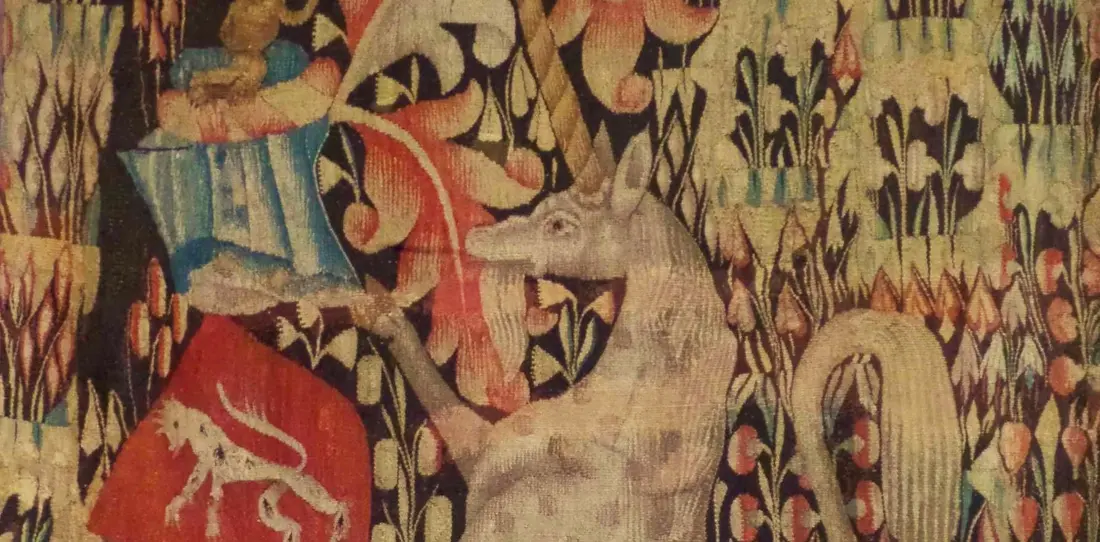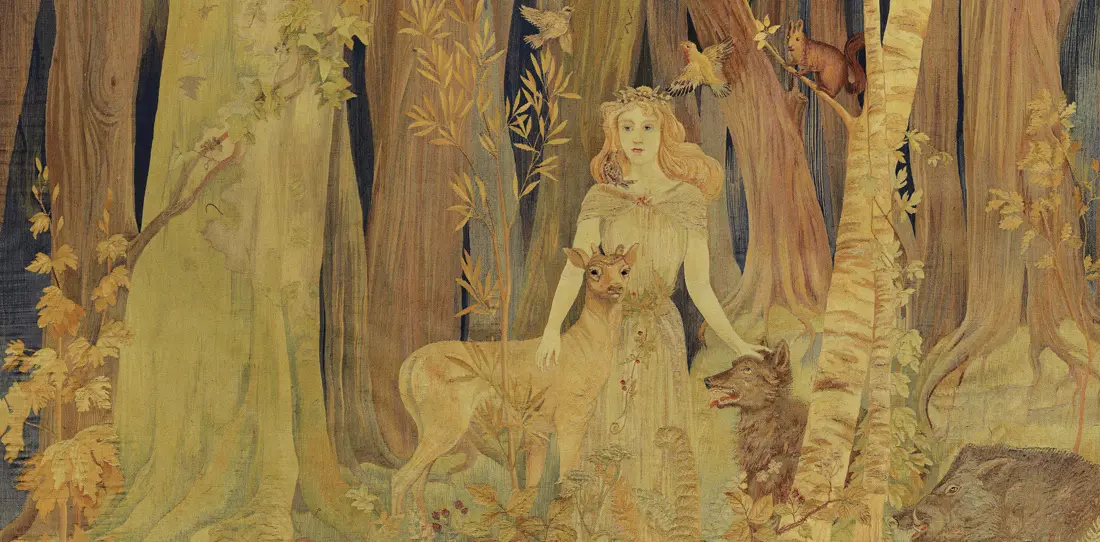6 centuries of history
Since the 15th century, Aubusson tapestry has established itself as an exceptional textile art, renowned for its refined designs and unique craftsmanship, recognised as part of UNESCO's Intangible Cultural Heritage.

The origins of Aubusson tapestry
The origins of Aubusson tapestry are the subject of several theories and legends, more or less fanciful. It is said, for instance, that Saracens settled in Aubusson in the 8th century, following the Battle of Poitiers (732), and brought with them this know-how from the Middle East. The writer George Sand also mentions the legend of the Ottoman prince Zizim, imprisoned in Bourganeuf (30 km from Aubusson) in the 15th century, who is said to have commissioned the famous tapestry of the Lady with the Unicorn to express his lost love. The reality is probably less romantic, and the origins of Aubusson tapestry are most likely to be found in Flanders, where this craft had already been flourishing since at least the 13th century. It was probably due to marriages between the Counts of La Marche (the name given to the region of Aubusson at the time) and wealthy families from northern Europe that weaving artisans settled in Aubusson and the nearby town of Felletin, bringing their know-how with them. The technique used is that of the low-warp, based on the use of horizontal looms. The earliest known archives mentioning tapestry-related activities in Felletin date from the mid-15th century.
16th century
The oldest tapestry identified as having been woven in the Aubusson region is the Millefleurs à la licorne, dated to the 1480s. Millefleurs tapestries were fashionable at the time, depicting backgrounds scattered with bouquets of plants, often with symbolic meanings. During the 16th century, private family workshops developed in Aubusson and Felletin, marketing their productions through merchant-weavers across France. It was during this period that the 'cabbage leaf' tapestries appeared, often depicting animal battles set among oversized leaves, as well as religious tapestries or hunting scenes.
17th and 18th centuries
Encouraged by the royal administration and by the protectionist economic policies led by Colbert, the weavers of Aubusson drafted regulations in 1665 to oversee the production and quality control of tapestries. That same year, the workshops of Aubusson collectively received the title of Royal Tapestry Manufacture. The Felletin workshops were granted the same privilege a few years later, in 1689. This status did not unify the workshops into a single entity; each remained independent but had the right to mark their productions with the 'M.R.' for 'Manufacture Royale.' A blue border for Aubusson and a brown one for Felletin allowed the origin of the tapestries to be identified. The status of Royal Manufacture was supposed to include the formation of a dyer and the sending of cartoons (tapestry designs) painted by the artists of the Royal Academy of Painting in Paris. However, these measures were not implemented by the royal administration, and the workshops faced significant difficulties at the end of the 17th century. It was not until 1732 that the Royal Manufacture status was reformed and the promises of 1665 were finally fulfilled. The king’s painter, Jean-Joseph Dumons, was assigned to the Aubusson workshops, providing them primarily with designs of greenery, tapestries depicting lush landscapes that were exported to the European nobility. The 18th century also saw the rise of 'à alentours' tapestries, decorative works with light-hearted subjects bordered by decorative motifs, which allowed the size of the weavings to be easily adapted to the dimensions of the paneling that decorated interiors.

19th century
In 1789, the French Revolution ended the status of Royal Manufacture, but did not interrupt the trade of the Aubusson workshops, despite economic difficulties. The early 19th century quickly saw the emergence of major manufactures, such as the Sallandrouze de Lamornaix manufacture (1802-1878) and the Demy-Doineau manufacture, which later became Braquenié and Cie. These companies brought together all stages of tapestry production, from designers to finishers who repaired old tapestries. The 19th century was marked by an abundant production of flat-woven rugs, which used the same technique as low-warp tapestry, and knotted pile rugs made on vertical looms, known as high-warp looms. The manufactures also produced many works copying 17th and 18th-century tapestries, with very fine weaving aimed at giving the illusion of painting. However, by the second half of the 19th century, artists and manufacturers began questioning this practice of copying paintings. The rediscovery of medieval tapestries, such as the Lady with the Unicorn and the Apocalypse of Angers, led some to encourage the use of fewer colours and a thicker weave. In Aubusson, there were early 20th-century experiments in this direction, such as Antoine Jorrand's tapestry La Fée des Bois, whose theme and border were clearly inspired by the Middle Ages. However, the real reform came through the work of Antoine-Marius Martin, who was appointed director of the Ecole Nationale d'Art Décoratif (ENAD) in Aubusson in 1917. Founded in 1884 to complement the training of weavers, Martin reconnected with modern artists by favouring designs specifically conceived for tapestry, and encouraged the abandonment of copying paintings through thick weavings and the use of textile-specific techniques. The results of his research were notably presented to the public at the 1925 International Exhibition of Decorative Arts.
20th century
It is based on these same researches that the painter Jean Lurçat relied when he arrived in Aubusson in 1937, to produce a series of tapestries in collaboration with the ENAD and the workshop of François Tabard. He was welcomed by Elie Maingonnat, Martin’s successor, who provided him with the resources of the school and trained him in the concepts of his former professor. Despite the success of this collaboration, it was interrupted in 1939 when Jean Lurçat publicly claimed the paternity of the research conducted by the ENAD since 1917. However, the story of Jean Lurçat and the Aubusson tapestry was just beginning, as he encouraged new artists to try their hand at tapestry, such as painters Marc Saint-Saëns and Jean Picart le Doux, as well as the Benedictine monk Dom Robert. In 1947, he founded, alongside them, the Association of Painter-Designers of Tapestry (APCT), which highlighted the role of the painter-cartoonist, who creates the design for their own tapestry and thus closely controls the manufacturing process. A charismatic figure, Lurçat would significantly contribute to the national and international renown of the Aubusson workshops, after the war, in a context of reconstruction where many public commissions were made. His legacy work, the tapestry series Le Chant du monde, remained unfinished and was acquired after his death by the city of Angers.